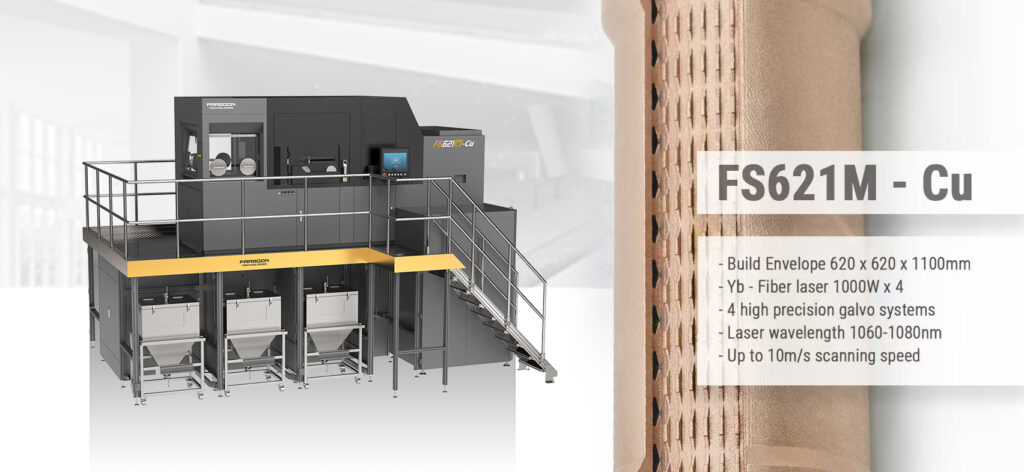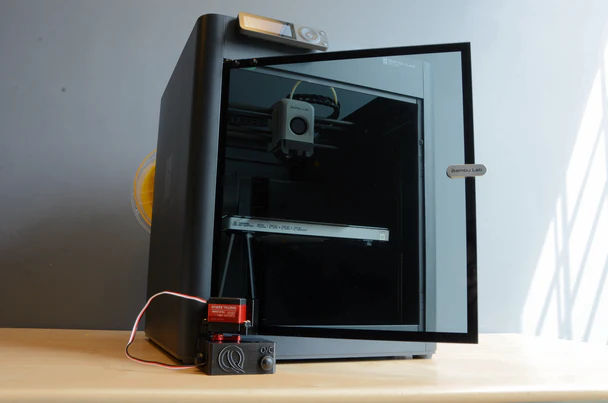We’re starting off with metals in today’s 3D Printing News Briefs, as Farsoon has unveiled a large-scale AM solution for copper alloys, and Meltio used its wire-laser metal solution to print a closed impeller for a fire suppression system. AML3D officially opened its new technology center in Ohio, which will support the broader AUKUS partnership and the U.S. Navy’s Virginia-class submarine program. Finally, we’ll close with desktop 3D printing news, as 3DQue has announced automated ejection for enclosed Bambu Lab 3D printers.
Farsoon Launches Large-Format Metal AM Solution for Copper Alloys
In 2017, Farsoon became one of the first companies in China to master 3D printing with copper alloys, which are great for use in aerospace engine combustion chambers due to their excellent ductility, corrosion resistance, and electrical and thermal conductivity. But because of their high reflectivity to near-infrared lasers, they can be tricky to use in AM. Now, building on its previous expertise, Farsoon worked with a top aerospace manufacturer to co-develop a large-format 3D printer designed specifically for copper alloys, based on its proven FS621M platform. With a 620 x 620 x 1100 mm build envelope, the new production-grade FS621M-Cu is said to achieve stable, long-duration printing of reflective materials, like CuCrZr, with its four integrated 1000W ytterbium fiber lasers (1060–1080 nm). The system uses LPBF technology to monolithically print copper alloy thrust chamber liners with optimized cooling channels.
A liquid rocket engine’s most critical component is the thrust chamber, which has to maintain precise regenerative cooling channels and withstand extreme pressures, temperatures, and vibrations. It’s very difficult to build, as traditional manufacturing uses expensive, lengthy, and labor-intensive processes like brazing, machining, and spinning. AM can be used to build a thrust chamber, but copper’s laser reflectivity can lead to defects, such as delamination, porosity, and warping. Farsoon’s new FS621M-Cu features a smart thermal management system, an anti-reflective chamber coating, and high-powered lasers, which help enable the production of a copper thrust chamber. The approach enhances engine performance and heat transfer efficiency, lowers production costs up to 75%, eliminates assembly steps, and majorly reduces lead times. The aforementioned aerospace customer successfully used the FS621M-Cu platform to build a 600 x 850 mm thrust chamber liner, which is said to be one of the largest ever 3D printed monolithic copper alloy components.
Meltio 3D Printed Closed Impeller for Fire Suppression System
When it comes to critical infrastructure, like fire suppression systems, downtime is not an option. Each time one of these systems starts up, its closed impeller has to go from zero to full speed in just seconds, forcing torque through nonstop to ensure that the system is pressurized. The impeller faces constant wear from corrosive flow, erosion, and vibration, so the question isn’t if this component will degrade, but when. Wire-laser metal deposition provider Meltio helped one of its customers reinvent this essential part, modifying it for printability and fast, responsive manufacturing. The impeller was traditionally made in cast bronze, extremely prone to wear and tear, and slow to source. The design was modified to stainless steel 316L for increased fatigue and corrosion resistance, and Meltio’s Radial 360 toolpath strategy was used to optimize its geometry, adding tailored supports for overhangs and variable deposition for cleaner finishes. It was split into two prints with the Meltio Engine Integration Kit for Robots, adding a machining pass in between and preserving the alignment with Meltio’s positioning system. The customer was able to achieve a stronger part with better wear resistance, reduced storage of spares, and rapid, on-site printing.
“By shifting from traditional casting to metal additive manufacturing, the customer gained more than just a part; they unlocked a superior process. This transition eliminated inventory backlogs and long waits for replacement parts, providing access to a better material that’s ready precisely when needed,” Meltio wrote.
“With Meltio, maintenance transforms into momentum, ensuring fire systems remain operational, secure, and prepared for any situation.”
AML3D Opens Advanced Manufacturing Technology Facility in Ohio
As the first phase in its U.S. expansion strategy, Australian wire arc additive manufacturing (WAM) provider AML3D Limited recently opened a new Technology Facility in Stow, Ohio, which represents a major milestone in strengthening its defense manufacturing capabilities in the U.S. The advanced manufacturing facility houses advanced manufacturing systems, like AML3D’s Arcemy, to serve defense, aerospace, and energy applications, and support the AUKUS partnership between the United States, Australia, and the United Kingdom, as well as the U.S. Navy’s Virginia-class submarine program. The grand opening ceremony, which was attended by defense industry leaders and representatives from local, state, and federal government, showcased the 6700 Edition ARCEMY X AML3D sold to the Tennessee Valley Authority, which further demonstrates the company’s contribution to the defense and energy infrastructure. The Ohio facility will improve onshoring by producing large-scale critical components for Virginia-class submarines using WAM, and is also expected to create local employment opportunities and develop training programs to prepare Ohio workers for careers in advanced manufacturing.
“This facility represents more than just an expansion of our operations – it’s a strategic investment in America’s defense industrial base. By establishing advanced manufacturing capabilities on U.S. soil, we’re helping to ensure the Navy has reliable, domestic access to the critical components needed for the submarine programs that are vital to national security,” said Pete Goumas, President and CEO of AML3D USA.
“This investment represents our confidence in Ohio’s skilled workforce and business environment. We’re committed to building long-term partnerships with local suppliers and educational institutions to create a sustainable advanced manufacturing ecosystem.”
AML3D also announced the appointment of Frederick J. Stefany to the Board of AML3D USA Inc. Most recently establishing the Navy’s Maritime Industrial Base (MIB) and serving as its first Program Manager, Stefany has over four decades of experience leading the U.S. Navy and Marine Corps’ R&D, acquisition, and sustainment programs across shipbuilding, aviation, weapons, and support functions.
3DQue Announces Fully Automated Ejection for Enclosed Bambu 3D Printers
Canadian 3DQue Systems builds automation infrastructure that makes 3D printing flexible, scalable, and resilient, using its AutoFarm3D platform to replace manual workflows with smart automation. It’s now released the AutoFarm3D Door Opener, which is the first auto-ejection hardware solution for enclosed Bambu Lab P1P, X1C, and X1E printers. Previously, users printing parts with high-temperature filaments such as ABS, PC, and PETG weren’t able to automate part removal, because the enclosures that are necessary to print with these materials blocked the ejection path. With its zero-touch part ejection and automatic door opening, the new AutoFarm3D Door Opener is the answer. This is great news for 3D printing farms that use enclosed Bambu printers, as the solution enables 24/7 production for these systems. This means less downtime, improved efficiency, and fewer interruptions, all for less than $200.
“Everyone’s been waiting for a way to auto-eject from enclosed Bambu printers. This is the last piece we needed to make full automation possible for every kind of 3D printing operation – even those using high-temp materials,” said 3DQue’s CEO Steph Sharp.
“Print farm operators have been asking for a way to automate enclosed printing. This is it. We’re proud to lead the way in print automation that’s both powerful and practical.”
The AutoFarm3D Door Opener is now available for pre-order, with shipments starting July 15th.





